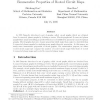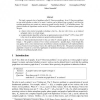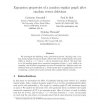39 search results - page 1 / 8 » Obtaining a Planar Graph by Vertex Deletion |
WG
2007
Springer
13 years 11 months ago
2007
Springer
In the Planar +k vertex problem the task is to find at most k vertices whose deletion makes the given graph planar. The graphs for which there exists a solution form a minor close...
GC
2010
Springer
13 years 3 months ago
2010
Springer
In 1966 Barnette introduced a set of graphs, called circuit graphs, which are obtained from 3-connected planar graphs by deleting a vertex. Circuit graphs and 3-connected planar g...
CORR
2010
Springer
13 years 5 months ago
2010
Springer
We study a general class of problems called F -Deletion problems. In an F -Deletion problem, we are asked whether a subset of at most k vertices can be deleted from a graph G such...
SIAMCOMP
1998
13 years 4 months ago
1998
We consider the problem of maintaining a dynamic planar graph subject to edge insertions and edge deletions that preserve planarity but that can change the embedding. We describe a...
EJC
2008
13 years 5 months ago
2008
We investigate the following vertex percolation process. Starting with a random regular graph of constant degree, delete each vertex independently with probability p, where p = n-...



